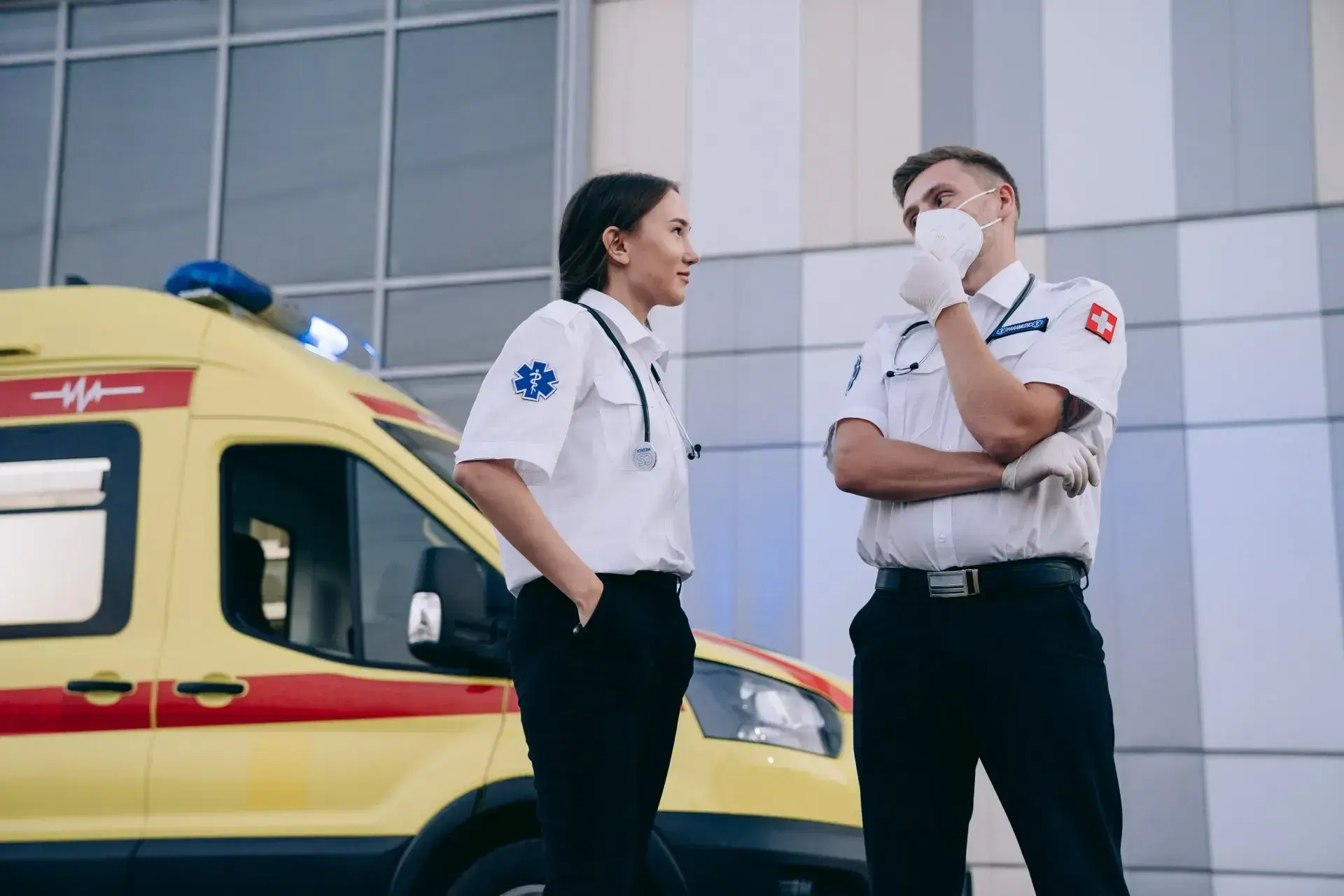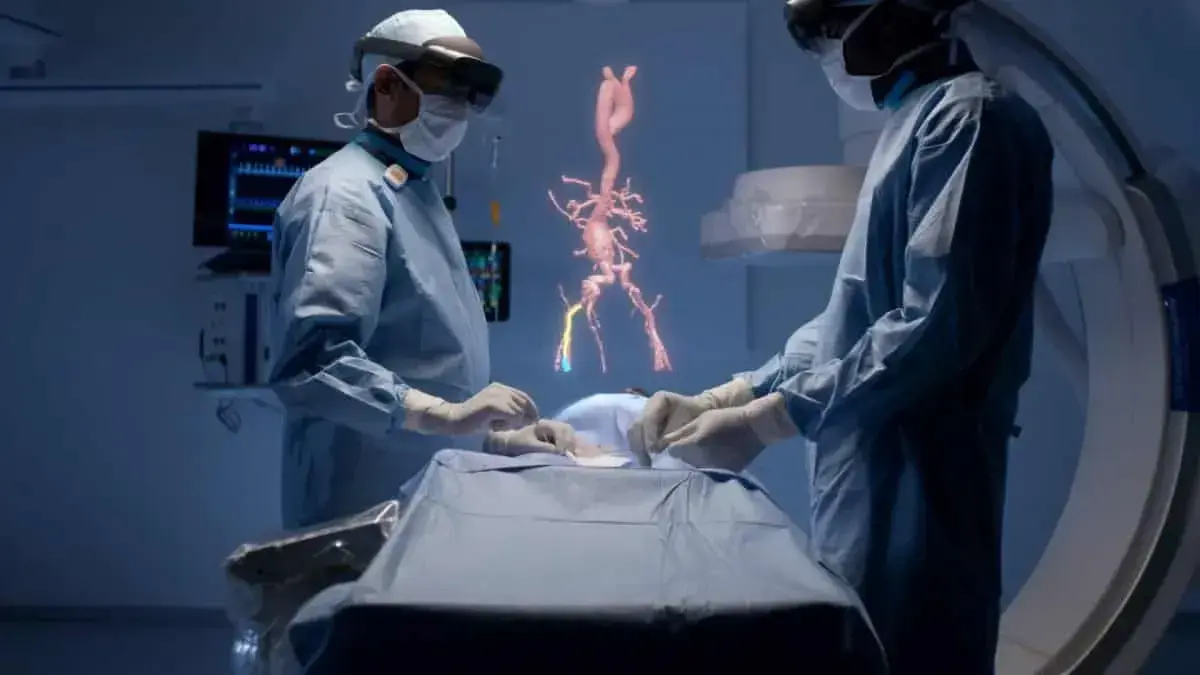Immersive Technology (XR) in the Healthcare Sector
Transform training and frontline care with assisted and augmented reality devices
Paramedics are the first responders in emergency situations, delivering critical care on the frontline. Their expertise, quick thinking, and ability to act under pressure save countless lives each year, especially in high-stakes scenarios. However, when specialised medical intervention is needed, paramedics are often constrained by time and geography. The urgency of the situation demands that patients be transported to the hospital swiftly, often from remote or hard-to-access locations. This transportation process can lead to delays in receiving the required specialized treatment, potentially impacting patient outcomes.
In recent years, technology, particularly smart glasses and mixed reality tools, has begun to bridge these gaps. For instance, paramedics can now leverage the power of smart glasses equipped with visible light cameras and holographic density for real-time access to medical data, guidance, and consultations. These devices, when integrated with an operating system like Microsoft Teams, enable paramedics to communicate instantly with medical professionals at the hospital, even while en route. Through mixed reality capture, paramedics can send live photos and videos to the hospital team, enabling them to assess the situation and prepare for the patient’s arrival.
The visor of these smart glasses displays critical information such as medical records, real-time updates, and instructions without distracting the paramedic. Additionally, the integration of cloud technology allows for seamless data transfer and access to a wealth of medical resources stored remotely. As smart glasses are continuously evolving, battery life has been extended to ensure that paramedics can rely on them throughout their shift without worrying about power limitations.
By utilising Microsoft Edge, paramedics can access web-based tools and applications that enhance their ability to make informed decisions quickly. With devices capable of capturing high-quality images and videos—measured in megapixels—paramedics can document injuries or medical conditions, which can then be analyzed by remote specialists. This real-time collaboration can be pivotal in making quick, accurate decisions that ultimately save lives.
Reviews of these smartglasses often highlight their ease of use, integration with existing medical tools, and potential for improving patient outcomes. They also mention how memory and performance, along with the ability to run apps on the go, make these devices a valuable tool for paramedics. Additionally, features like Microsoft Teams allow for streamlined communication, enabling paramedics to stay connected with doctors, nurses, and other emergency services while performing their duties.
The future of paramedic care is increasingly intertwined with advancements in mixed reality and smart glasses. These devices hold the potential to revolutionise emergency care by providing paramedics with the technology to make more informed decisions on the go. This will ensure that patients receive the best possible care as quickly as possible—no matter where they are. With the integration of cloud services, battery life advancements, and holographic capabilities, the possibilities for improving emergency response are limitless.
Improve paramedical care
The problem
Paramedics deliver urgent care on the frontline. Their expertise and quick thinking saves countless lives every year.
However, when specialist intervention is needed, paramedics are constrained by time and geography. Patients must be transported to hospital, fast – often from remote or hard-to-access locations.

The solution
Delivering expert guidance via real-time voice and video link is transforming emergency care, allowing professionals to provide critical support even in remote or challenging environments. With the introduction of devices like the first HoloLens and its successors, paramedics can now receive live assistance from medical experts during emergencies, enhancing their decision-making and effectiveness on the frontlines.
Expert guidance
Deliver expert guidance via real-time voice and video link.
Eliminate skill gaps
Eliminating skills gaps in emergency medical care is crucial to ensuring optimal patient outcomes, especially when access to specialised medical knowledge is limited. With devices like HoloLens 2, paramedics and healthcare professionals can access medical specialisms on demand, bridging the gap between frontline responders and expert medical teams.
Safety
Maintain focus and safety with lightweight, distraction-free wearables.
Save lives
Save lives by administering critical care more quickly and effectively.
Deliver immersive training experiences
The problem
Training demonstrations provide valuable, interactive learning opportunities for students. However, educators are limited in the scope of their simulations. Dummies and role play can only go so far in replicating the stress and excitement of real-world medical scenarios.

The solution
Create interactive experiences that feel powerful and real. By using mixed reality in healthcare education, students can experience surgical and first-aid scenarios as if they were happening before their eyes. It's all thanks to some very clever technology, which allows for virtual elements to be integrated seamlessly into real-world learning environments.
With the help of our devices, you can unlock learning opportunities across a wide range of disciplines – from first aid, to surgery, to disaster management.
Bespoke experiences
Deliver bespoke experiences that cover any eventuality.
Cost saving
Save cash by ditching expensive, single-purpose training equipment.
Learning opportunities
Introduce practical, on-the-job learning opportunities without risk.
Virtual testing environment
Make adjustments on the fly to test and challenge students.
Streamline remote observation and guidance
The problem
In an ideal world, your specialists could attend to any situation instantly. However, the reality is that resources are limited. At best, doctors are forced to travel outside of working hours. At worst, patients face delays in their treatment until specialist care is available.

The solution
Let doctors dial in to any situation, instantly. Frontline workers wear assisted reality video headsets, which allow specialists to assess and advise from a remote location. This means assessments can be carried out quickly and efficiently, without the need for costly, time-consuming travel.
The technology opens up powerful training opportunities too. It allows junior doctors and nurses to access expert guidance from specialists who might be miles away, or even in a different country.
Expertise for all
Make expertise available to all, without the need for travel or recruitment.
Cut waiting times, boost productivity
Cut patient waiting times while boosting productivity and wellbeing among staff.
Training from anywhere
Deliver top-of-the-line care and training from any location.
Maintain safety standards
Maintain safety standards with comfortable, distraction-free wearables.
Simplify pre-surgery analysis
The problem
All forms of surgery have risks attached. However, despite advances in medical imaging and pre-operative assessment, surgeons have few opportunities to practice their craft before entering theatre. This means increased patient risk and reduced efficiency, at a time when the medical industry is under enormous financial pressure.

The solution
Empower surgeons to assess and practice operations without risk. Equipped with virtual or augmented reality headsets, surgeons can explore realistic 3D visualisations of patients' organs. By determining the best operative route before surgery begins, surgeons can boost efficiency and improve patient outcomes.
Medical aids
Root out unexpected complications before they happen.
Intuitive
Get started immediately with intuitive, easy-to-wear VR headsets.
Cut costs, greater efficiency
Deliver first-class surgical treatment with lower costs and better efficiency.
Reduce stress with technology
Reduce stress for surgical staff.

Product spotlight
Discover the tech you need to change lives and unlock new cost savings
These assisted and augmented reality medical devices have hundreds of potential uses, ranging from training in university environments to time-critical collaboration in frontline care.
Assisted reality headsets connect wearers with remote users via voice and video link. They're ideal for delivering training and advice, and feature distraction-free displays so users maintain total awareness of their environment.
Augmented (or mixed) reality glasses allow for virtual elements to inhabit real-world environments. This opens up exciting opportunities for multi-user training sessions and pre-surgical assessments.
Mōziware Cimō Smart Glasses
Assisted reality glasses, with a 2 year subscription to Simply Video
Cimō turns anyone into an instant expert. Equipped with cimō, your teams can access remote expertise, share knowledge and collaborate across borders. Plus, it's totally hands-free. With its twin HDR cameras and intuitive voice controls, staff can communicate safely, seamlessly and effectively.
- Two HDR cameras
- Lightweight and compact
- High-resolution display
- Industrial noise cancellation
- Market leading technology

Magic Leap 2
Assisted reality glasses
The Magic Leap 1 is an extremely lightweight wearable computer, ideal for mixed-reality training exercises where focus and agility are needed. It can be used with a controller module, or hands free with voice commands and hand tracking.
- Three core processors for realistic 3D virtualisations
- High-resolution screens deliver immersive mixed reality experiences
- Comfortable design – ideal for lengthy simulations
- Built-in battery; USB-C charging

Microsoft HoloLens 2
Assisted reality headset
With fully articulated hand tracking, the Microsoft HoloLens 2 delivers truly immersive training simulations and data visualisations. Advanced spatial mapping lets you anchor virtual elements to real-world objects.
- Hands-free operation allows for total focus in high-pressure simulations
- High-resolution waveguide displays seamlessly blend the real and the virtual
- More than 200 mixed reality apps are available, right out of the box
- Built-in batteries; USB-C charging
Vuzix M4000
Assisted reality glasses
The Vuzix M4000 is a rugged assisted reality solution designed for seamless communication in the field. It's ideal for long shifts, as the battery can be replaced without the unit losing power.
- Lightweight and comfortable form factor
- Can be controlled with its built-in buttons or with voice commands
- Delivers crisp real-time video with a side-mounted camera and waveguide display
- Hot-swappable battery; USB-C charging

How is assisted and virtual reality used in healthcare?
Our solutions are already saving lives and helping forge new standards of efficiency and care.
VR and adjacent technologies are enjoying widespread adoption among healthcare organisations around the world. By 2026, the medical VR market is expected to be worth more than £1,800 million, with a compound annual growth rate of 33.1%.¹
Why? It's simple: our technology improves standards, boosts efficiency and empowers practitioners to collaborate like never before.
Transform your healthcare proposition – embrace the new reality of lifesaving tech today.
SimplyVideo
Time-critical collaboration made simple.
When quality of care is at stake, you need a communications solution that works quickly and reliably.
SimplyVideo is a video conferencing platform built especially for time-critical circumstances. It works seamlessly in low-bandwidth locations, delivering crisp, real-time video and audio when you need them.
This means you can expect messages to arrive loud and clear, without buffering or breaking up. No delay. No room for miscommunication.
SimplyVideo is designed, from the ground up, for assisted reality devices. Only SimplyVideo lets you deliver next-level collaboration where it's most needed – the frontline.

